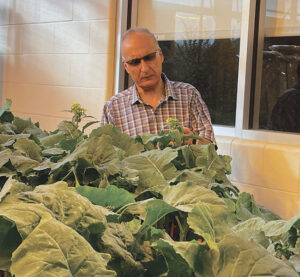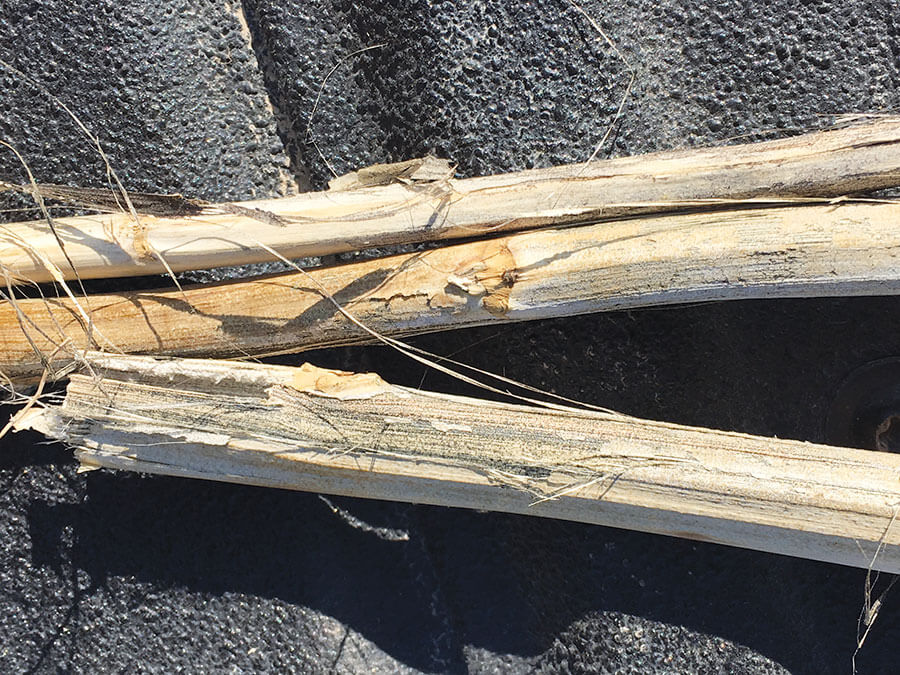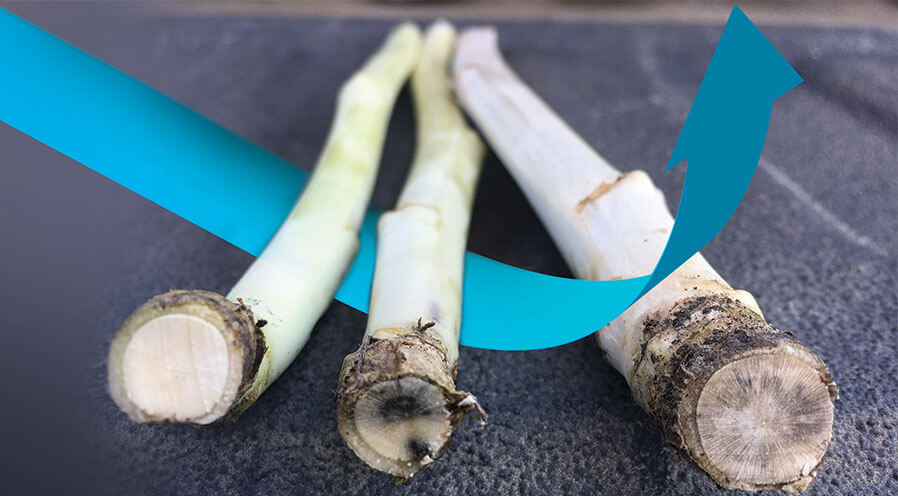The rise of verticillium stripe
Verticillium stripe is coming under greater scrutiny as the canola sector digs deeper into finding how much of a threat it poses, and how to defend against this stem disease.
First discovered in Manitoba in 2014, verticillium stripe in canola has since been found in other provinces, including Saskatchewan and Alberta.
2022 Prairie disease surveys
The Western Committee on Plant Diseases’ Oilseed Diseases Report for 2022 showed Manitoba most affected by verticillium stripe. In an examination of 116 fields across Manitoba, verticillium stripe was found in 38 per cent of canola crops (prevalence), with 23 per cent of plants showing symptoms in fields with the disease (incidence). Across all 116 fields surveyed in Manitoba in 2022, the average incidence of verticillium stripe was 8.7 per cent.
Verticillium stripe’s prevalence has been on a steady upward trajectory in Manitoba. Below 10 per cent in 2018, prevalence levels reached 30 per cent in 2020 and 2021, and nearly 40 per cent in 2022 – a level similar to sclerotinia stem rot.
“Clubroot originated in Alberta and made its way east, and some people say blackleg originated in Saskatchewan and made its way east and west, and in that kind of analogy, we could say that verticillium has been more prevalent in Manitoba, and seems to be moving westward. But we don’t have full documentation on that.”
—David Kaminski
David Kaminski, Manitoba Agriculture field crop pathologist, points out that prevalence alone falls well short of telling whole story, as it merely shows how many of the fields surveyed have any symptoms. Prevalence doesn’t address incidence within a field, nor the severity of the disease, he says.
Preliminary observations for Saskatchewan’s 2022 after-swath verticillium-specific survey, which targeted areas in eastern Saskatchewan, revealed verticillium stripe was “no longer a rare disease in eastern Saskatchewan.” In Alberta, out of 353 canola fields surveyed, the prevalence of suspected verticillium stripe was 2.4 per cent, and average incidence 0.1 per cent.
It’s not clear why Manitoba levels are higher than the rest of the Prairies.
“Clubroot originated in Alberta and made its way east, and some people say blackleg originated in Saskatchewan and made its way east and west, and in that kind of analogy, we could say that verticillium has been more prevalent in Manitoba, and seems to be moving westward,” Kaminski says. “But we don’t have full documentation on that.”
Yield loss
A lot remains to be determined about verticillium stripe, Kaminski says. That includes a lack of a rating scale for severity of verticillium stripe, and only anecdotal reports of the seriousness of yield losses.
“In Europe, where the disease has been present for around 30 years, yield losses range from 10 to 50 per cent,” adds Canola Council of Canada (CCC) agronomy specialist Courtney Boyachek. She says yield losses caused by verticillium stripe can be very inconsistent within a field and across growing regions. Research is underway to uncover yield implications in Western Canada.
Symptoms
The most commonly observed symptoms of verticillium stripe are found on canola stems and roots, Boyachek says. These symptoms include necrosis, stunting, discolouration, and wilting, which will appear on all parts of the plant due to verticillium stripe causing interference of water and nutrient uptake, she explains.
“In Europe, where the disease has been present for around 30 years, yield losses range from 10 to 50
per cent.”
—Courtney Boyachek
“What we are looking for when scouting is stem senescing on half of the plant, showing stem infection on the lower stem, and then moving up onto the branches,” Boyachek says.
Stems may become bleached and brittle, and, as necrosis sets in, the stem epidermis will start to peel off, like wallpaper peeling off a wall, she adds. “This reveals the microsclerotia within the stem, giving a ‘pepper-like’ look to the inside of the stem,” Boyachek says. “The roots will also start to show peppering, as well as a star-burst like pattern when you cut the stem for a cross section.”
This darkened cross section may seem like blackleg. The brittle stems may seem like sclerotinia stem rot. That is why identifying verticillium stripe in the field can prove challenging, but accurate identification will be easier with experience.

“The shredding of the stem symptom is comparable to sclerotinia, however, the hollowing of the stem and larger sclerotia bodies from sclerotinia is different from the smaller microsclerotia present from verticillium stripe,” Boyachek says.
Looking at the cross section of the stem after cutting it at ground level can help tell the difference between blackleg and verticillium. “Verticillium will present some general discolouration, generally in a starburst like pattern. Blackleg will present itself in a distinct solid black wedge covering a percentage of the stem,” Boyachek explains. Verticillium discolouration also tends to extend farther up the stem. CCC recommends scouting for symptoms post-harvest.
Management
No fungicides or seed treatments are currently available for control of verticillium stripe, a soil-borne disease that can live in the soil for 10 to 15 years. As a result, growers are limited to implementing best management practices to mitigate the risk of infection. These include eliminating host crop weeds like volunteer canola and wild mustard every year, and applying biosecurity practices such as equipment and tool sanitation, and controlling field traffic, says Boyachek. Extending crop rotations is also recommended.
If you suspect you have verticillium stripe in your fields, submit plant samples to your province’s respective lab, she recommends. “Knowing it’s in your field is the first step to managing the disease,” Boyachek says.
Genetic resistance
Genetic resistance would be ideal, and the pathogen’s emergence has generated interest in developing a resistant cultivar. No commercial varieties are considered to be verticillium stripe resistant, although a University of Manitoba lab found genetic resistance in Canadian and Chinese germplasm.

Hossein Borhan, research scientist with Agriculture and Agri-Food Canada in Saskatoon, also has a project to identify verticillium-resistant canola lines. He says resistance to verticillium stripe is multigenic, which means breeding for resistance could be a challenge because it may require multiple genes with minor effects. His lab’s work to map the location of verticillium resistance genes, a project funded by the Canola AgriScience Cluster, is in progress.
“A main question remains to be answered is: how important is verticillium stripe for canola production and yield in Canada? If it is not an economically important disease, then monitoring the disease and rotation could be sufficient to keep verticillium stripe under control,” says Borhan.
Right now, Corteva Agriscience is the only company promoting a verticillium score. Its seed brand Brevant has several hybrids with verticillium scores of five or six, including Brevant Seeds’ B3012 and B3014 LibertyLink hybrids. The range is one to nine, with nine being most resistant and one most susceptible. These trait rating scores are based on comparisons with other Brevant products, not competitive products, and are assigned by Corteva research managers.
“Later-maturing products seem to have a little bit better verticillium stripe score,” says Ellis Clayton, Corteva’s technical product manager for Western Canada. “I think it ties to the life cycle of when the disease hits, and it’s our earlier maturing products that seem to get hit a little harder with verticillium stripe.”






